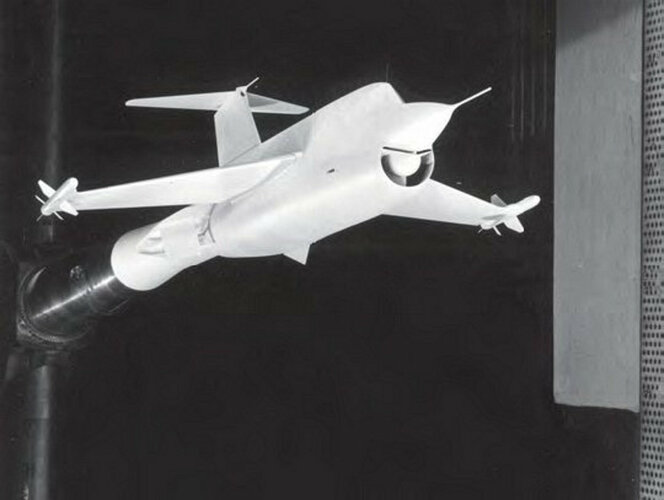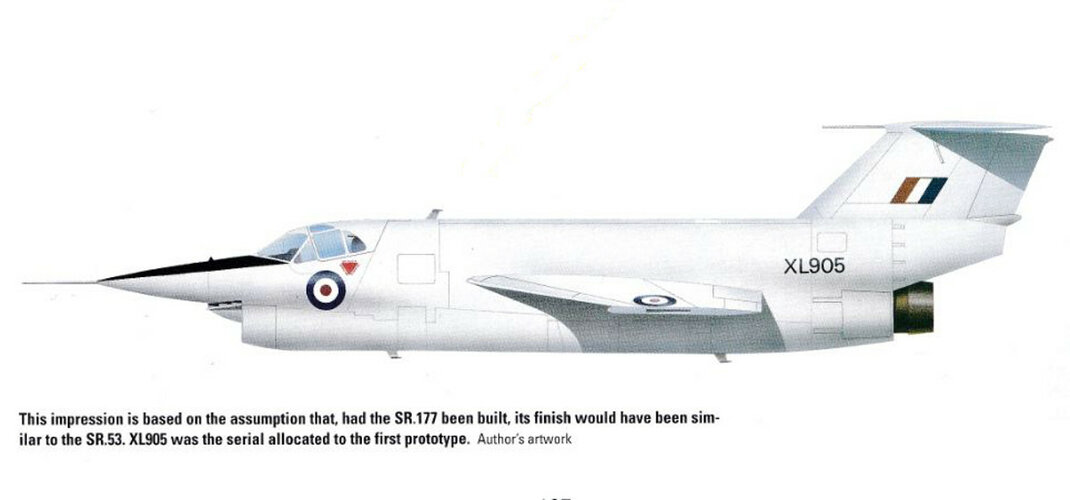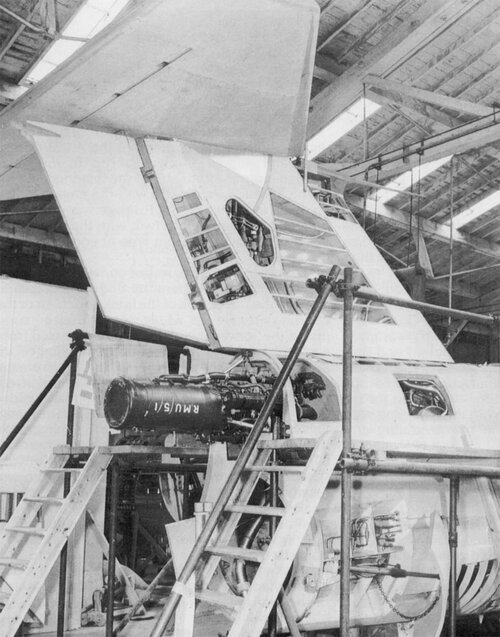The mixed rocket-jet propulsion may not seem very sensible in hindsight, but it was attractive enough to be pretty widely considered. Even the Mirage III design included a rocket pack.
When the SR.177 was conceived, I think several factors made the rocket attractive:
* Early jet engines were comparatively slow to accelerate.
* Afterburners were in their infancy, and getting them to work safely, reliably, and relatively economically while providing worthwhile additional thrust took some time. Just compare the eyelid nozzles on an early Mirage to those on an F-16 to see how far things have come.
* The naval and air-force doctrine of the time prioritized interception of fast, high-altitude, nuclear-armed targets. Jet-fighter range and endurance were still relatively modest, so combat air patrol at long range was not practical. This put a premium on maximum rate of climb immediately after takeoff.
Rockets have several significant advantages:
- Their thrust doesn't lapse away at high altitude.
- A typical first-order approximation for a jet would be to assume thrust proportional to δ/√θ. This effectively says that the specific thrust is constant and the axial Mach number at the compressor face is fixed, which is reasonable provided that T20 doesn't get unreasonably high.
- They don't run out of T30 margin at high Mach number.
- They don't have intake momentum drag.
- In the context of a mixed power aircraft with a supersonic dash capability, this can greatly simplify the intake design, because high pressure recovery at high MN is not required. This can save quite a lot of weight (as later demonstrated by F-16).
Taken together, these factors can make a relatively small rocket quite compelling near the top-right corner of the flight envelope.
| Altitude | Mach Number | δ (total) | θ (total) | Non-dimenional thrust | Jet thrust | Total thrust
(rocket = 10,000 lbf) | Jet thrust as a proportion of total thrust |
|---|
| 0 km | 0.0 | 1.0000 | 1.0000 | 100% | 14,000 lbf | 24,000 lbf | 58% |
| 0 km | 0.8 | 1.5243 | 1.1280 | 144% | 20,160 lbf | 30,160 lbf | 67% |
| 0 km | 1.2 | 2.4250 | 1.2880 | 214% | 29,960 lbf | 39,960 lbf | 75% |
| 11 km | 0.8 | 0.3415 | 0.8486 | 37% | 5,180 lbf | 15,180 lbf | 34% |
| 11 km | 1.2 | 0.5433 | 0.9690 | 55% | 7,700 lbf | 17,700 lbf | 44% |
| 11 km | 1.6 | 0.9522 | 1.1375 | 89% | 12,460 lbf | 22,460 lbf | 55% |
| 11 km | 2.0 | 1.7529 | 1.3541 | 151% | 21,140 lbf | 31,140 lbf | 68% |
| 20 km | 0.8 | 0.0832 | 0.8481 | 9% | 1,260 lbf | 11,260 lbf | 11% |
| 20 km | 1.2 | 0.1323 | 0.9684 | 13% | 1,820 lbf | 11,820 lbf | 15% |
| 20 km | 1.6 | 0.2319 | 1.1368 | 22% | 3,080 lbf | 13,080 lbf | 24% |
| 20 km | 2.0 | 0.4270 | 1.3534 | 37% | 5,180 lbf | 15,180 lbf | 34% |
This very simple model is optimistic in its jet thrust prediction at higher Mach numbers, because it implies perfect intake pressure recovery, and no T30 limit. It also neglects the increase in rocket thrust with altitude due to reduced ambient pressure increasing the pressure thrust term.
Despite this, the rocket is the dominant source of thrust at altitude.
The SR.177 was, if anything, a fairly conservative application of the mixed power idea. It's predecessor, the SR.53, was conceived as a light, short-range interceptor for the RAF, where the rocket was the main source of combat of combat power, as in the Me163. The Viper turbojet was intended mainly to allow post intercept recovery to a suitable airfield. A reusable SAM of sorts.
As you can see from the sample calculations above, the lapse behaviour of the jet engine means that the rocket is the dominant source of thrust at high altitude. However, what matters in the interception business is the ability to gain total specific energy. For a slow aircraft, this is basically synonymous with height, but for a supersonic aircraft the kinetic energy term becomes significant.
An aircraft flying at Mach 2 and 11 km on a standard day is flying at about 590 m/s TAS. This is equivalent to about 17.75 km of energy height, so the majority of its energy is kinetic rather than potential.
From an energy perspective, what matters is (specific excess) power, i.e. the rate of doing work. This is the product of thrust and velocity, and therefore a rocket does no useful work on a static vehicle. The mixed power fighter is more attractive than the pure rocket because its jet engine has a much better TSFC and can allow the rocket to be reserved for use at high velocities when it is more effective at rapidly increasing the energy state of the vehicle.
Mixed power interceptors are perfectly sensible, and can reasonably be expected to out-perform jets if high altitudes are required, provided that the duration of the rocket burn is fairly short. This is because the thrust-to-weight ratio of the rocket is much better than that of the jet, especially at altitude.
E.g. a Spectre is about 430 lbm, so the thrust-to-weight ratio of the engine itself was about 20. The ISP was about 200 seconds, so the TSFC was about 18 lbm/lbf/hr.
However, the Gyron Junior only has a static thrust-to-weight ratio of about 4.5 with reheat at sea level (referenced to the dry engine weight, i.e. excluding any supersonic intake).
If we consider the Mach 2.0 / 20 km case, the TSFC of the jet is probably about 2.0 with reheat. The thrust-to-weight ratio under these conditions is only 37% of the number we first thought of, so about 1.7.
We may now compare the jet and the rocket, using a "rubber" jet engine:
| Duration (minutes) | Weight of jet scaled to 10,000 lbf | Mass of jet fuel | Total weight for Jet | Weight of rocket + fuel for 10,000 lbf | Mass of rocket propellant | Total weight for Rocket |
|---|
| 0 | 5985 lbm | 333 lbm/minute | | 430 lbm | 3,000 lb/min | |
| 1 | .. | 333 lbm | 6,318 lb | .. | 3,000 lbm | 3,430 lbm |
| 2 | .. | 666 lbm | 6,651 lb | .. | 6,000 lbm | 6,430 lbm |
| 3 | .. | 1000 lbm | 6,985 lb | .. | 9,000 lbm | 9,430 lbm |
The rocket is much lighter than the jet, provided that the thrust duration at high altitude is short.
In reality, the total weight of the jet system would be rather heavier than this due to the intake system, and this would tend to increase the cross-over duration.
Because the jet makes less thrust at lower speeds for want of intake ram, the cross-over duration would be significantly longer if subsonic manoeuvre or transonic acceleration were considered.
Also, because in-flight-refuelling would be unlikely to replenish oxidizer, it is probably attractive to over-size the oxidizer capacity somewhat in order to improve combat persistence, so the 7 minutes of rocket endurance quoted for SR.177 is pretty reasonable.
Modern engines have higher thrust-to-weight ratios, and might be expected to double those available to the SR.177. Specific impulse hasn't really improved much, so the optimum rocket duration would probably be less today.
The main reason for the demise of the mixed power interceptor was the demise of the high altitude supersonic bomber, which left it bereft of targets. However, if the optimists are correct in forecasting a proliferation of supersonic business jets in the next few decades, it may be that there is a renewed interest in very high performance manned interceptor aircraft, and in that case the mixed power concept would be worth revisiting.
Finally, nasty as high-test hydrogen peroxide can be (I have seen the effect of smallish amounts on human flesh in the lab), would it really be any more dangerous and impractical aboard ship than the gasoline that navies had accepted for decades?
HTP demands respect, but the traditional way to make it safe is to dilute it with water, which is readily available at sea. It is also pretty dense, so the volume to be stored and protected is fairly small. I think it's a pretty reasonable liquid oxidizer when compared with the alternatives.

















